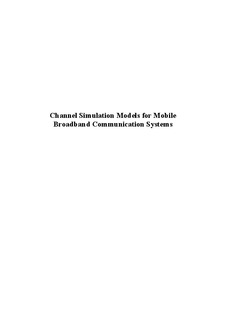| dc.description.abstract | Mobile broadband wireless communication systems (MBWCS) are emerging as
a solution to provide broadband services to users on the move. These systems
are expected to operate in a wide variety of propagation scenarios, at different
mobile speeds, and at various frequency bands. Under such a variety of requirements,
flexible and efficient channel simulation models will prove fundamental
for the laboratory analysis of MBWCS. Currently, most of the existing channel
simulation models are either too complex as to allow for an efficient performance
investigation of MBWCS, or they cannot be applied to the simulation of some relevant
classes of mobile fading channels. To overcome these limitations, we present
in this doctoral a flexible and efficient methodology for the design of channel simulation
models for MBWCS. Such a methodology is based on the sum-of-cisoids
(SOC) approach, an approach that is closely in line with the electromagnetic
plane-wave propagation model.
We build our channel simulators upon a class of ergodic SOC simulation
models. For the computation of the SOC model parameters, we introduce two
simple methods that enable the design of simulation models for mobile fading
channels characterized by any type of Doppler power spectral densities (DPSDs).
The proposed methods are well-suited for the simulation of both single-input
single-output (SISO) and multiple-input multiple-output (MIMO) channels. We
evaluate the methods’ performance with respect to their accuracy for emulating
important statistical functions of the channel, such as the autocorrelation function
(ACF), the envelope probability density function (PDF), and the ACF of the
squared envelope. In the case of MIMO channels, we evaluate the methods’
performance in terms of the approximation of the channel temporal ACF and
spatial cross-correlation function (SCCF). The obtained results demonstrate the
excellent performance of the proposed methods.
This dissertation is also intended to provide a comprehensive treatise of the
theory behind the design of SOC simulation models for mobile fading channels.
In this respect, the statistical properties of SOC channel simulators are thoroughly
analyzed. Important contribution are given concerning the correlation
properties of the square envelope of SOC simulators. Such contributions include
the derivation of closed-form expressions for the squared envelope ACF of the SOC simulation model, and the analysis of the ergodicity properties of the SOC
model’s squared envelope.
We also revisit here the concept of the symbol-spaced tapped line model
(SSTDL) for WSSUS channels. In this regard, we present a discussion on the
problems of SSTDL models, and we propose a simple solution to avoid them.
The usefulness of such a solution is exemplary demonstrated by analyzing the bit
error probability of a multi-carrier code division multiple access (MC-CDMA)
system. | en |
